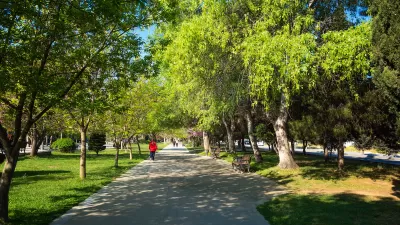The city has outlined 11 strategic priorities aimed at addressing the risks of extreme heat and protecting vulnerable residents from its impacts.

A plan dubbed ‘Shade Phoenix’ pledges to plant 27,000 trees and build 550 shade structure in Phoenix in the next five years to tackle the growing problem of extreme heat.
In a piece for Environment and Energy Leader, Kaleigh Harrison explains that the initiative is part of the city’s Office of Heat Response and Mitigation, the first such department in the nation. “The Shade Phoenix Plan includes 36 action items and 11 strategic priorities aimed at reducing heat vulnerability. These initiatives incorporate cooling strategies like cool corridors and heat-reducing materials.”
The plan also emphasizes equity, noting that resources should be fairly distributed among the city’s neighborhoods and address the needs of communities most vulnerable to extreme heat. “City officials stress that shade infrastructure is essential public health infrastructure, not just an aesthetic upgrade. Extensive community outreach shaped the plan, ensuring it addresses diverse.”
FULL STORY: Phoenix Launches Shade Plan to Tackle Urban Heat Crisis

Alabama: Trump Terminates Settlements for Black Communities Harmed By Raw Sewage
Trump deemed the landmark civil rights agreement “illegal DEI and environmental justice policy.”

Planetizen Federal Action Tracker
A weekly monitor of how Trump’s orders and actions are impacting planners and planning in America.

The 120 Year Old Tiny Home Villages That Sheltered San Francisco’s Earthquake Refugees
More than a century ago, San Francisco mobilized to house thousands of residents displaced by the 1906 earthquake. Could their strategy offer a model for the present?

LA’s Tree Emergency Goes Beyond Vandalism
After a vandal destroyed dozens of downtown LA trees, Mayor Karen Bass vowed to replace them. Days later, she slashed the city’s tree budget.

Sacramento Leads Nation With Bus-Mounted Bike Lane Enforcement Cameras
The city is the first to use its bus-mounted traffic enforcement system to cite drivers who park or drive in bike lanes.

Seattle Voters Approve Social Housing Referendum
Voters approved a corporate tax to fund the city’s housing authority despite an opposition campaign funded by Amazon and Microsoft.
Urban Design for Planners 1: Software Tools
This six-course series explores essential urban design concepts using open source software and equips planners with the tools they need to participate fully in the urban design process.
Planning for Universal Design
Learn the tools for implementing Universal Design in planning regulations.
Ada County Highway District
Clanton & Associates, Inc.
Jessamine County Fiscal Court
Institute for Housing and Urban Development Studies (IHS)
City of Grandview
Harvard GSD Executive Education
Toledo-Lucas County Plan Commissions
Salt Lake City
NYU Wagner Graduate School of Public Service





























